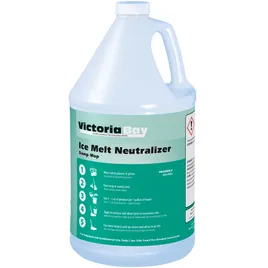Every year, the winter months increase the risk of occupant slips and falls due to snow and ice.
Ice melt greatly reduces that risk, but it can also be tracked into your building leaving your entryways and/or hallways filled with white streaks.
These residues not only create a hazy, unclean floor appearance, but they can degrade floor finish and damage the surface of your floors.
Residues must be removed to keep floors protected and looking great during the winter months.
How Do You Remove Ice Melt and Salt Residue From the Floor?
In this article and video, we’ll go over 4 key steps to safely remove white streaks and residue from commercial hard floors.
Steps to Remove Ice Melt Residue or Salt Residue From Hard Floors
Before beginning any cleaning procedure, start by putting on the proper personal protective equipment (PPE).
Step 1: Remove Floor Mats

An entry matting system will stop the majority of contaminants such as ice melt, salts, soils, and water from entering your facility. However, even with a high-quality matting system ice melt residue can be tracked beyond the entryway and seep under the mat.
You’ll need to remove the floor mats from the area to be cleaned. Do not try to clean around the mats. Water and other wet residue can seep under the mat and damage the floor.
Step 2: Remove Debris
Sweep any large debris or ice melt from the floor.
Step 3: Select a Floor Neutralizer
The most important step in removing white streaks and ice melt residue is to select the right floor cleaning product.
Many ice melts contain salt which can negatively react with floor cleaners.
Learn More about Ice Melt Compounds: What is Ice Melt? Selecting The Best Ice Melt For Your Facility
To avoid floor damage and any adverse reactions, you will need a floor neutralizer.
Floor neutralizers are specifically designed to dissolve ice melt chlorides, soap, and hard water films as well as scum, scale, and other organic residues. Floor neutralizer will both clean the floor and eliminate white residue so you only have to perform one floor care procedure.
Do not try to use a cleaner with a high or low pH. Aside from potentially dangerous chemical reactions, high or low pH cleaning chemicals will not be effective at removing the residues. The pH of salts, which is the most common compound in ice melt, is very high.
Floor neutralizer also limits the risk of removing the finish on your floor.
Step 4: Apply Floor Neutralizer
Before beginning, remember to place wet floor signs around the area you will be working in to alert occupants of wet areas and warn them of the slip and fall risk.
Properly dilute the neutralizer according to the manufacturer’s instructions.
You can apply floor neutralizer with either a mop and bucket or with an automatic floor scrubber.
Mop and Bucket Method
The mop and bucket method is a manual procedure that requires several steps.
First, apply the floor neutralizer with the mop across the area to be cleaned. Always work in manageable areas so that the product doesn’t dry before you can remove it.
Once you have thoroughly applied the floor neutralizer to the area, you’ll need to replace the solution in the bucket with clean water and rinse the mop. It is important to exchange the dirty cleaning solution and thoroughly clean the mop to avoid re-depositing salt and ice melt residue back to the floor.
Next, rinse the floor (if stated on the product label) with clean water (not all neutralizers need to be rinsed).
Finally, let the floor dry and inspect for any white streaks. If there are still white streaks remaining, repeat the process.
Auto Scrubber Method
Using an auto scrubber to remove white streaks is extremely efficient when compared to the mop and bucket method. It is also safer.
With an auto scrubber, the floor neutralizer is applied and removed with fresh water in one step. Unlike the mop and bucket method, your staff don’t have to exchange the dirty solution or clean the mop, saving them time.
Additionally, during the one pass, the floor is dried, eliminating long dry times and the risk of occupant slips and falls.
When using an auto scrubber, make sure to thoroughly clean the entire machine before storing.
Salt residue can transfer from the floor to the machine’s various parts during the cleaning procedure and can be damaging to the machine. Salt is corrosive and can reduce the effective life of wear-and-tear parts such as the squeegee, tanks, and other metals on the machine.
Final Thoughts
Ice melt helps promote safety and can be a great tool to minimize snow and ice on sidewalks and near entryways. However, keeping ice melt from being tracked into your facility is a necessity but also a challenge.
The best way to protect your floors will be to frequently remove the buildup with a floor neutralizer.
In high traffic areas like entryways and corridors, we recommended removing ice melt residue with a floor neutralizer once every two hours.
Keep in mind, every facility is different. If you don’t see a buildup of residue or hazy appearance then you can reduce the frequency of this cleaning procedure. Similarly, if you notice a lot of streaking or buildup within 2 hours, consider increasing the frequency to every hour.
Imperial Dade locations have an unrivaled selection of commercial cleaning products and janitorial cleaning equipment to help you protect your floors from ice melt build-up during the winter.
If you’re located in the United States or Canada, Contact a specialist today for help finding the best floor neutralizer to keep your commercial hard floors looking their best this winter.


